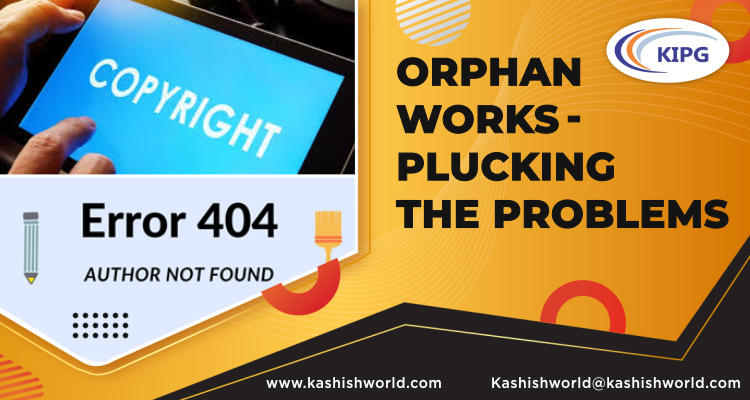
With the advancement of technology and accessibility to every common man, the production of creative works has increased. It includes a wide array of works, including amateur photography and movies to poems and novels. Since physical copies may be hard to maintain, digitization has become far easier through online outreach. Many of these works are commercially viable but do not have an identified author, which is from where the issue sprouts up.
What are Orphan Works?
As may be evident from the name itself, ‘Orphan Works’ are those works that exist out there in the open but are not acclaimed by anyone. Therefore, they are owner-less works since the author cannot be identified. The same includes everything ranging from World War I photographs to anonymous blog posts.
They are different from ‘pseudonymous works,’ which are essentially those works, which utilize a stage name or name other than the authentic name of the author to maintain secrecy or to build on a character different from one’s personality. An example could be Judith Barton, who uses Madeline Elster as her pseudonymous name commonly attributed to the Alfred Hitchcock film ‘Vertigo.’
Another fact that needs clarification here is that every other work falling into the public domain is not an orphan work. Where Copyright Protection is exhausted; and the work falls in the public domain, it simply ceases to generate exclusive benefits to the owner and; the ‘ownership’ is not deemed to be extinguished. The owner and his work remain well intact. For instance, famous films like Buster Keaton’s Sherlock, Jr. and The Navigator, Paramount Pictures’ 1924 adaptation of Peter Pan, and Henry Otto’s Dante’s Inferno have all entered into the public domain this year. But they are not ‘Orphaned.’
What is the Problem?
There are reports that state that about 80% of all copyrighted works are orphan. They are often spotted in a dusty untouched corner of a library or museums or attics. Since these orphan works do not belong to any particular author, they run at the risk of being destroyed as no one has the economic incentive to preserve such works.
 Another common issue lies in the most fundamental aspect of copyright itself, i.e., since copyright comes into existence, the very moment it is created, irrespective of being registered. Without registration or recordal of rights, finding the author becomes a herculean task.
Another common issue lies in the most fundamental aspect of copyright itself, i.e., since copyright comes into existence, the very moment it is created, irrespective of being registered. Without registration or recordal of rights, finding the author becomes a herculean task.
These works are vulnerable to undue exploitation due to mass digitization and easy availability. Everyone with an internet connection and a digital device can discover such works and use it without proper authorization. The problem lies in the approach that should be opted for when dealing with such works. Should these orphan works be published out in the open for the public to use against the copyright norms, or should they be tucked under the bed and made inaccessible to the public?
Why should we be Looking for a Solution?
The following reasons pre-empt the need to find a solution before we witness a soar in cases and conflicts:
a)- Digitization: As also asserted above, digitization has raised the alarm bells since there are many institutions, museums, and libraries that are digitizing these collections and making them available for use. Here comes the unanswered question of ownership and the extent of the permitted use.
b)- The Google Problem: Google has scanned and placed over 15 million books, which are accessible by its users. It is for this reason Google is in constant conflict with interested parties worldwide since early 2000.
c)- Extension of Copyright: Earlier, copyright was protected for a shorter span. However, now, the usual lifecycle lasts for at least the lifetime of the author plus another 70 years. In such a long duration, many of the works often go out of print or are usually orphaned or abandoned due to lack of another interest in sustaining the work of an author who would be long gone by then.
d)- Safeguarding Cultural Art: Locating the works belonging to recognized Hollywood-produced, well-acclaimed artists, major music label producers, etc., is convenient. However, the works of minorities, women, and many other disadvantaged groups are arduous to uncover. The same brings in the issue of cultural and native heritage being vulnerable to commercial exploitation.

e)- The licensing Issue: If one does not know who the author is, making legitimate use of such work through seeking a license or an agreement becomes impossible. It invites the legal risk of civil infringement and criminal liability when such works are utilized for commercial utilization.
f)- Finders Keepers Problem: It is easier to take advantage of such works by simply claiming wrongful authorship to extract monetary gains from the creation of another. It was also witnessed in the US Author’s Guild vs. Google, wherein Google digitized and made some specific books with limited revelations accessible to the public. Although Google was making profitable gains from such a venture, it could take cover under the fair-use provision. In this case, the problem was not seen to be very adverse; however, it could be so in different cases.
Approach Taken by the EU and UK
The European Union enacted the Enterprise and Regulatory Reform Act (ERA), and the United Kingdom imbibed the same in the form of section 116(5) of the Copyright, Designs and Patent Act, 1988 (CDPA). These two specify the need to conduct a ‘diligent search’ to obtain the status of an orphan work, whether it is published or unpublished and whether such works belong to the UK or EU or not. Furthermore, these works can be facilitated by publicly accessible libraries, educational establishments, museums, archives, film or audio heritage institutions, and public service broadcasting organizations, and the exception only applies to non-commercial activities.
Approach Taken by the US

The US has a Report of Orphan Works and Mass Digitization, which incorporates the EU and the UK’s principles, including the diligent search requirement. Also, in the case of finding the author of such works, the author shall be ‘reasonably compensated,’ but the same may not be compensated where the use is made by non-profit entities like educational institutions, museums, libraries, etc. The report identifies the changes that should be introduced in the US Copyright system to introduce limited liability of bonafide users whether the work is used for commercial purposes or otherwise. Also, it suggests that for orphan works, a different symbol should be incorporated after obtaining a Notice of Use from the Copyright Office.
Policy Measures: The Way Forward

a) Adopting a Wider Definition of Fair-Use: The fair use provision should be widely interpreted to incorporate the use of orphan works as well. The US Copyright Act has devised a four-factor test to interpret whether the use falls under the said exemption, including:
(1) The purpose and character of the challenged use;
(2) The nature of the copyrighted work;
(3) The amount and substantiality of the taking; and
(4) The effect of the use on the market for the work.
Although there is no mention of protection of orphan works under the fair use provision either in the US, India, or the UK, it is strongly advocated that such works should be made available for bonafide use, including teaching, scholarship, commenting, research, reporting, etc. The same would extend the ability of society to benefit from such resources. It is for this reason that several judicial decisions have been titled in favor of memory institutions like libraries, museums, etc., for their practice of cultivating digitization of orphaned works and loaning the same as being fair use.
b) Digitization for Non-Commercial Use as a Specific Exemption: Another progressive step could be where different nations agree to make accessible orphan works to each other through digitization for the good of mankind and enable research-oriented activities. The move was widely adopted through the EU Directive on Certain Permitted Uses of Orphan Works.
c) Centrally Granted License: Other policy measures that are adopted in Canada, Japan, Korea, India, and Hungary include the measures wherein orphan works are centrally regulated by the granting of licenses. It helps to ensure un-infringing implications even if the work is commercially exploited. Such a license can be offered after reasonable steps and measures have been taken, and the author remains undiscovered.
d) Extended Collective Licensing: The most preferred policy measure is the use of Extended Collective Licensing (ECL) since they offer protection against the infringing use of copyright with a lower transaction cost, unlike other suggested measures. Through the ECL-measure, the author of the orphan works, although not identifiable, is represented by a collective management organization that acts in the prior’s interest. This policy is embraced by several jurisdictions, including Hungary, the Czech Republic, Sweden, Norway, Denmark, Iceland, and Finland.
An additional measure could be the effort of actually uncovering the life of existent works. It would help bifurcate works that are already in the public domain versus those which need to be safeguarded by them being orphaned. Many organizations and public libraries have taken this initiative into their own hands, like the HathiTrust Digital Library, the New York Public Library, etc.
Conclusion
Orphan works are a potential challenge for users as well as policy-makers. While users face the threat of litigation at the time of utilizing such works since authorization becomes difficult to obtain in the event of an unidentified author, the policy-makers face the challenge of choosing between a liberal and a stringent regime to make such works available for the benefit of either the users or the unidentified author. The same is a constant dilemma, and maintaining a balance between a private, unidentified entity and the public at large becomes imperative. Although the fair-use exception is not the exact answer since it covers only non-commercial use, a suitable regime in favor of both institutional and non-institutional users and both commercial and non-commercial uses of orphan works is warranted. Such measures should also include provisions to incentivize the creation of transformative new works by building on works of creativity reasonably considered orphaned by minimizing the deterrent effect of possible injunctions and statutory damages.

